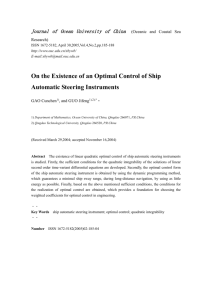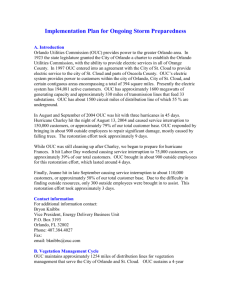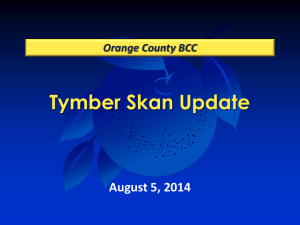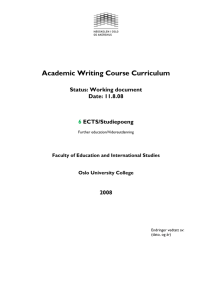OUC Facility Connection Requirements
advertisement
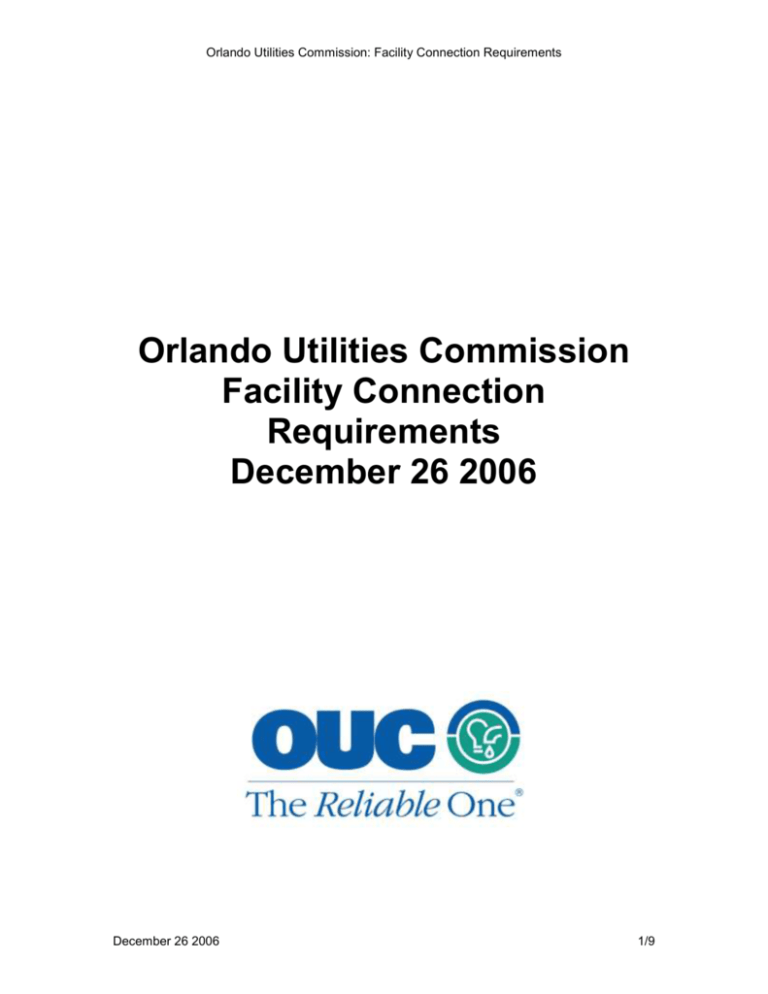
Orlando Utilities Commission: Facility Connection Requirements Orlando Utilities Commission Facility Connection Requirements December 26 2006 December 26 2006 1/9 Orlando Utilities Commission: Facility Connection Requirements TABLE OF CONTENTS Introduction 1.0 Introduction 1.1 Purpose 1.2 Application 2.0 Connection Requirements 2.1 Procedure for Connection Studies 2.2 Procedure for Notifying of FRCC and Others of Proposed Project 2.3 Voltage Level, MW & MVAR Capacity at Point of Connection 2.4 Breaker Duty and Surge Protection 2.5 System Protection and Coordination 2.6 Metering and Telecommunications 2.7 Grounding and Safety 2.8 Insulation 2.9 Voltage, Reactive Power and Power Factor Control 2.10 Power Quality 2.11 Equipment Ratings 2.12 Synchronizing of Facilities 2.13 Maintenance Coordination 2.14 Abnormal Frequency and Voltage 2.15 Inspection Requirements 2.16 Communications and Procedures during Normal and Emergency Operating Conditions 3.0 Administrative 3.1 Revisions 3.2 Availability December 26 2006 2/9 Orlando Utilities Commission: Facility Connection Requirements 1.0 Introduction The OUC Facility Connection Requirements serves as a general outline for generation, transmission and end user facilities that connect to the OUC transmission system. This document is based on NERC standard FAC-001-0. This document is not intended to be a detailed manual but a general overview of procedural and technical requirements. This document does not supersede NERC, FRCC, FERC, OATT, NESC, NEC, IEEE and OUC standards. In the event of a conflict the other document should be considered the ruling document. Throughout the document the phrase “industry standards” is used. This term refers to NERC, FRCC, FERC, OATT, NESC, OSHA, NEC, IEEE and OUC standards as well as best practices. This document applies to non-OUC entities who wish to connect to the OUC Transmission system and refers to them as “transmission user”. OUC recommends that a transmission user keep their entire facility compliant with industry standards. OUC requires new transmission user facilities that can affect the performance of the OUC and neighboring transmission systems comply with this document. During project negotiations a determination will be made as to which facilities impact OUC’s transmission, and which do not. The specifications listed in this document are the same requirements that OUC facilities meet or exceed. During studies and technical review no preference is made between OUC and non-OUC facilities. 1.1 Purpose These requirements are placed on OUC Transmission users to insure that the OUC transmission system remains compliant with NERC, FRCC and OUC standards. Compliance with these standards is necessary to insure a safe and reliable power transmission system. 1.2 Application This document applies to all new generation, transmission and end user facilities that directly connect to the OUC transmission system and are not owned by OUC. OUC’s facilities meet or exceed the following specifications. December 26 2006 3/9 Orlando Utilities Commission: Facility Connection Requirements 2.0 Connection Requirements 2.1: Procedure for Connection Studies In general for all connections to the transmission system there will be three studies performed. The naming convention and content of these studies is based on the FERC OATT studies of similar name but the procedure may be applied to more than just OATT studies. Feasibility Study: A Feasibility study is a quick assessment of the proposed project based on previous studies, general knowledge of system performance and dedicated studies of the transmission system. The purpose of this study is to provide a quick initial assessment of the project impacts and if changes to the transmission system will be required. The documentation of this study may be informal or formal. Impact Study: The Impact study is a detailed study that looks at the impact of the proposed project on the transmission system of OUC and neighboring utilities. The study identifies any transmission system changes that might be required to accommodate the project and keep the transmission system compliant with industry standards. This study may include Load Flow, Short Circuit, Stability, and other types of analysis as required. The Impact Study may also include analysis by FRCC and neighboring utilities on the impact of the project to the overall transmission system and their specific parts. Facility Study: The Facility study occurs after the Impact study is completed and develops the actual physical implementation plans for the facility connection. During the facility study additional analysis may occur, such as power quality and protection coordination. Depending on the customer there may not be a single document labeled “facility study”, but instead the collection of design, estimate and supplemental studies may be considered the facility study. There are specific requirements established by FERC, FRCC and OUC’s OATT for some types of connections that may expand upon or supersede the preceding procedure. OUC may charge a fee for performing these studies based on the type of connection and size of the project. Any study fee will be negotiated and paid prior to the study being performed. December 26 2006 4/9 Orlando Utilities Commission: Facility Connection Requirements 2.2: Procedure for Notification of FRCC and Others of Proposed Project Project Notification for Joint Study: If the proposed project meets certain criteria established by the FRCC and OUC, OUC will contact the FRCC to set up a joint study. A review of the project will then be initiated per FRCC Procedures. If the project does not meet the level of FRCC Review, OUC may still contact entities that may be impacted and have them review the project. Project Notification for Modeling: Once the project moves into the facility study stage (occasionally earlier) it will be added to the FRCC databank and the FRCC Project schedule by either the project owner or OUC. 2.3: Voltage Level, MW & MVAR Capacity at Point of Connection The transmission user and OUC will discuss the available voltages, MW & MVAR capacity at the point of connection during the feasibility and impact studies. This information will be used to perform the studies and will be forwarded to the FRCC at the appropriate time per section 2.2 above. 2.4: Breaker Duty and Surge Protection The transmission user’s equipment that affects the performance of OUC’s transmission system will meet or exceed OUC’s requirement for similar equipment and coordinate with OUC’s own system. Consideration should be given for forecasted system growth in the selection of equipment. 2.5: System Protection and Coordination The transmission user’s equipment that affects the performance of OUC’s transmission system will meet or exceed OUC’s requirement for similar equipment and coordinate with OUC’s own system. Consideration should be given for forecasted system growth in the selection of equipment. December 26 2006 5/9 Orlando Utilities Commission: Facility Connection Requirements 2.6: Metering and Telecommunications Metering: The metering equipment required will be determined by the rate, size and type of facility. Any metering equipment provided by the transmission user for OUC use will meet or exceed applicable OUC and industry standards. Telecommunications: The transmission user shall provide telecommunications facilities sufficient to meet OUC’s telephone, radio, system protection, remote meter reading, EMS and SCADA requirements. OUC will specify the type, speed and characteristics of the communication channel equipment so that compatibility with existing communications, supervisory control, relaying and telemetering equipment is maintained. The specific type of communication equipment to be furnished by the requesting entity will be reviewed and approved by OUC. The requesting entity may have to reimburse OUC for the costs of any additional facilities provided by OUC. Fiber optic additions to new or existing OUC transmission lines will be considered on a case-by-case basis. Technical analysis of clearances, structural loads and electrical field effects may limit applications. Outage restrictions and maintenance responsibilities may also impact potential paths. OUC reserves the right to charge a fee for ROW, pole attachments and/or acquire individual optical fibers on the circuit, per agreement between the interconnecting entity and OUC. 2.7: Grounding and Safety The transmission user’s equipment that affect the performance of OUC’s transmission system or the safety of OUC personnel will meet or exceed OUC’s requirement for similar equipment and coordinate with OUC’s own system. Consideration should be given for forecasted system growth in the selection of equipment. 2.8: Insulation The transmission user’s equipment that affects the performance of OUC’s transmission system will meet or exceed OUC’s requirement for similar equipment and coordinate with OUC’s own system. Consideration should be given for forecasted system growth in the selection of equipment. December 26 2006 6/9 Orlando Utilities Commission: Facility Connection Requirements 2.9a Voltage, Reactive Power and Power Factor Control: Generating Stations Voltage: Generating Stations are responsible for regulating the voltage at their interconnection point. All voltage regulation equipment for the generating station will be approved by OUC and will be compliant with industry standards and best practices. Installations where the combined generation exceeds 50 MVA and some smaller installations may be required to install a power system stabilizer. Reactive Power: All generating stations will be expected to provide reactive power as requested by OUC and the security coordinator to support local voltage. The generating station equipment relating to reactive power capability and control will be reviewed by OUC for compliance with applicable FERC, NERC, FRCC, OUC and other applicable standards. Power Factor: Power plants are expected to provide and absorb reactive power as required. 2.9b Voltage, Reactive Power and Power Factor Control: Transmission facilities Transmission facilities that generate power would fall under section 2.9a; those that use power should refer to 2.9c. 2.9c Voltage, Reactive Power and Power Factor Control: End Users Voltage: Transmission facility additions may be studied for their impact on system voltage levels during the impact study, facility study and post installation. Voltage studies may include both steady state and fluctuations due to load characteristics. Transmission users may be required to pay for system improvements due to unacceptable steady state voltage and/or unacceptable voltage fluctuations caused by their facility. Reactive Power: Transmission users are expected to provide the majority of their reactive power requirements. Excessive reactive power requirements and/or rapidly changing reactive power requirements may require system improvements at the transmission user’s expensive. Power Factor: Transmission users are expected to maintain a power factor as close to 100% as practical. 2.10 Power Quality The power quality impact of a facility may be assessed during the facility study and post installation. The cost to remedy power quality problems generated by the transmission user will be the responsibility of the transmission user. December 26 2006 7/9 Orlando Utilities Commission: Facility Connection Requirements 2.11 Equipment Ratings The transmission users equipment that affect the performance of OUC’s transmission system will need to meet or exceed OUC’s requirement for similar equipment and coordinate with OUC’s own system. Consideration should be given for forecasted system growth in the selection of equipment. 2.12 Synchronizing of Facilities All facilities with generation that intend to connect to the grid with their generation operating will be required to have at least one functional synchronizing check relay (IEEE Device 25) that supervises the connection and prevents asynchronous closing. Additional synchronizing requirements will be negotiated in the agreement. 2.13 Maintenance Coordination Maintenance Coordination If the transmission user requires an outage to perform maintenance they should contact OUC as far in advance as possible. Maintenance on Transmission User’s Facilities that Impacts OUC Transmission: For equipment that is designated as having an impact on OUC transmission performance the transmission user is required to perform maintenance as recommended in OUC, manufacturer and industry standards. OUC reserves the right to inspect equipment and maintenance records to insure the equipment is being properly maintained. 2.14 Abnormal Frequency and Voltage The transmission system in Florida generally experiences voltages between 90% and 106% of nominal, and frequencies between 59.9 and 60.1 hz. It is possible during a rare system events that voltages and/or frequency to exceed these limits. The transmission user is responsible for installing any protective devices necessary to protect their system from these rare excursions. 2.15 Inspection Requirements Inspection requirements will vary depending on the type and size of the facility. These requirements will be established during the facility study and adjusted as needed during implementation. In general OUC reserves the right to inspect as needed any user facilities that can impact the OUC transmission systems. These inspections may be routine, random or based on a system event or complaint. December 26 2006 8/9 Orlando Utilities Commission: Facility Connection Requirements 2.16 Communication and Procedures during Normal and Emergency Operating Conditions During normal and emergency operating conditions the OUC operations groups and the State Security Coordinator is charged with maintaining a safe and reliable transmission system in Florida. All transmission users are expected to immediately follow directives issued by the OUC operations groups, the State Security Coordinator or their designee when those directives are considered critical to maintaining the transmission system. Specific details on communication and procedures will vary depending on the type, size and location of the facility and will be established on a case by case basis. 3.0 Administrative 3.1 Revisions This document will be reviewed on a yearly basis for compliance with the current NERC and FRCC requirements. In between yearly reviews this document may be revised as necessary. 3.2 Applicable Version This document becomes applicable to all Transmission users upon publication on the FLOASIS site. 3.3 Availability This document is available on the FLOASIS site in Adobe format. December 26 2006 9/9



